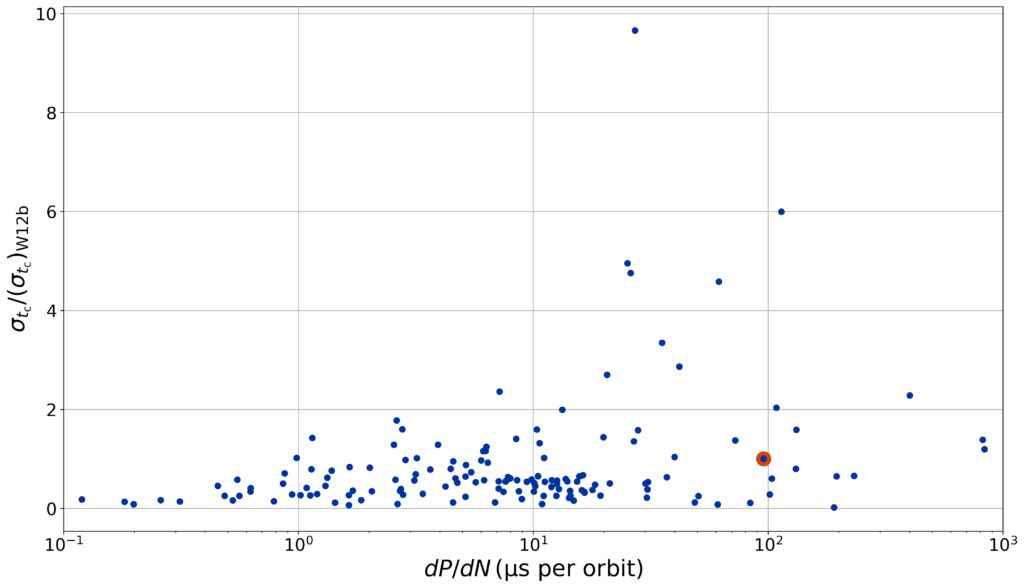Jackson et al. (2023). “Metrics for Optimizing Searches for Tidally Decaying Exoplanets.” AJ, 166, 4.
hot jupiters
All posts tagged hot jupiters

WASP-12 b is in trouble. A giant ball of mostly hydrogen, the planet circles its star once every 25 hours. The resulting intense stellar irradiation drives super-sonic storms of plasma around the world, and the atmosphere has so much thermal energy, in fact, that some of it is escaping into space. But it gets worse. WASP-12 b is steadily tumbling toward its host star, and astronomers expect that, within a few million years, the star will eat the planet.
WASP-12 b is one of a few hundred hot Jupiters, gas giants very close to their stars, and so far, it’s the only one we have confirmed in a death spiral. Many other hot Jupiters probably are probably also condemned, but how many more can we find perched on the edge of destruction? And, come to think of it, how did the planets find themselves in such precarious positions in the first place? To answer these questions, astronomers need to understand how many hot Jupiters there are out there and how many more are left to be found.
Continue ReadingHot Jupiters are gas giant planets like Jupiter but orbiting so close to their host stars that they can be as hot as small stars. In fact, some suffer such strong irradiation that their atmospheres are being blasted off into space. These objects were among the first exoplanets detected, and their origins and fates remain unclear.
Being so hot, their atmospheres are also unlike any planet’s in our solar system, but we can be certain that, with temperatures hot enough to vaporize rock, the weather on these planets is highly dynamic. The video below shows what happens to one such planet as it gets blast-roasted by its host star – a giant thermal wave screams around the planet.
Weather forecasts on hot Jupiters would to have keep track of super-sonic winds, ruby rain, and warm fronts heated by magnetic fields. And a recent study using observations from the Hubble Space Telescope shows that these dynamic atmospheres remain mysterious.
Led by Jacob Arcangeli of the University of Amsterdam, the study used the Wide-Field Camera onboard Hubble to watch WASP-18 as the hot Jupiter circled its star.
As the planet swings revolves around its star, we see first the cool nightside of the planet and then the blistering dayside. By measuring the diurnal cycle of infrared light emitted from the two sides of the planet, called the phase curve, Arcangeli and colleagues were able to measure their respective temperatures and learn something about the planet’s weather.
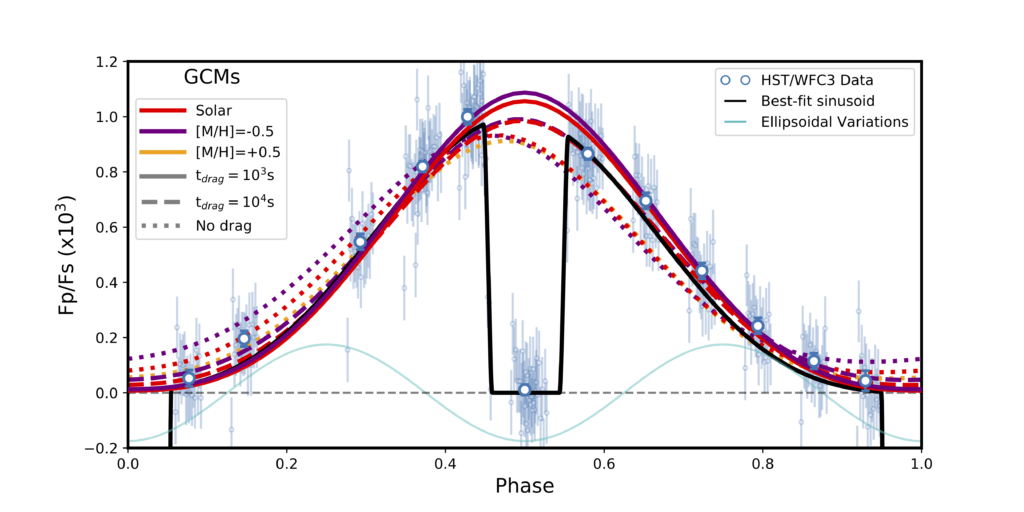
The figure above shows WASP-18b’s phase curve as blue points and a model fit to the data as a black line. By applying computer simulations for the planet’s weather, Arcangeli and colleagues estimated what they expected the phase curve to look like various assumptions about the planet’s composition and atmospheric dynamics.
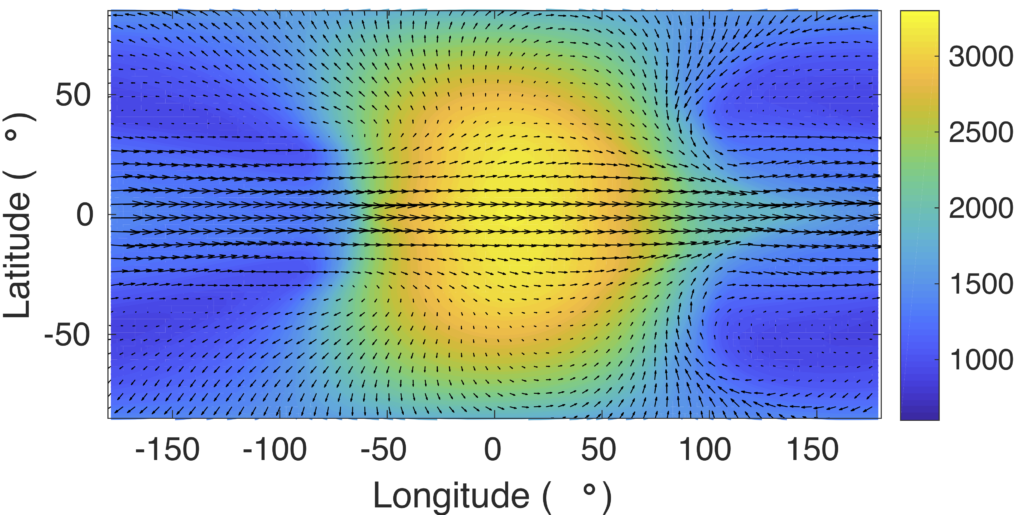
Using their models, they were able to draw a rough map of temperatures in WASP-18b’s atmosphere (shown above), like a weather map for the Earth. Like most hot Jupiters observed show far, the hottest place in WASP-18b’s atmosphere lies a little east of the point that receives the most sunlight, the substellar point. That’s because high windspeeds blow the strongly heated gas away toward the east, a little like the jet stream on Earth.
However, the winds inferred from the Hubble observations weren’t as strong as expected from the model, suggesting there is some form of drag or friction in WASP-18b’s atmosphere.
The likely culprit: the planet’s very own magnetic field. Gas in WASP-18b’s atmosphere is actually so hot, it can become somewhat plasma-fied, and plasma, consisting of hot charged particles, can interact with the hot Jupiter’s magnetic field.
This is totally unlike planets in our own solar system, where the atmospheres are comparatively cool and none of the gas has turned into plasma.
The upshot of this result is that we may be able to use observations of the meteorology on distant worlds to learn something about the planets’ magnetic fields, which originate deep inside the planet. So their weather may allow us to plumb the depths of these distant worlds.
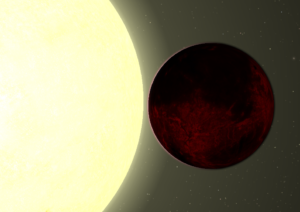
Artist’s conception of the ultra-short-period planet Kepler-78 b, discovered by Sanchis-Ojeda and colleagues in 2013.
An eyebrow-raising paper emerged recently from Prof. Josh Winn and colleagues about a type of planet near and dear to my heart, ultra-short-period planets, or USPs for short.
These planets are roughly the size of Earth and probably rocky but are hundreds of times closer to their host star than the Earth is to the Sun. These planets are so hot some have melted daysides and others are evaporating. Because they’re so much closer to their stars, ultra-short-period planets zip around their stars in just hours – hence the clunky name.
Our group, along with others, has suggested USPs might be the remnants of hot Jupiters (gas-giant planets close to their stars) that had their atmospheres ripped off. If so, we’d expect systems hosting USPs to resemble systems hosting hot Jupiters.
One distinctive feature of stars with hot Jupiters is that they have more iron (Fe) and other heavy elements in their atmospheres. Astronomers call the amount of heavy elements (“metals”) stellar metallicity. Hot-Jupiter host stars are heavy in metals probably because planets form from the same materials as the star and big planets need large amounts of metals to form. The same trend doesn’t seem to hold for small, roughly Earth-sized planets, though – small planets don’t seem to be as picky. So, if USPs are hot Jupiters that lost their atmospheres, their stars should also be metal-rich.
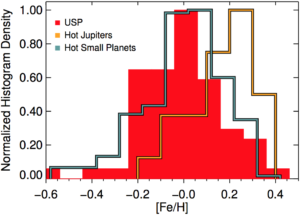
Figure 4 from Winn et al. (2017), showing the distribution of stellar metallicities for USP-hosting stars (red), hot Jupiter-hosting stars (orange), and stars hosting small but slightly longer period planets (blue).
But the recent paper from Winn and colleagues throws this origin story for USPs into doubt. In their study, they looked at metallicities for stars hosting USPs, stars hosting hot Jupiters, and those hosting small planets a bit farther out than USPs, all discovered by the Kepler Mission. The figure at left shows their results.
As expected, the orange curve for hot Jupiter hosts peaks toward higher metallicity (that is, toward bigger [Fe/H]-values), and if USPs are former hot Jupiters, the red histogram should look like the orange one.
Instead, it looks a lot like the blue one for smaller, farther out planets. This result suggests that USPs are just like their longer-period cousins – planets that have always been small, just with very short periods.
What to make of this? There’s some statistical wiggle room, allowing some, but not all, USPs to have been hot Jupiters, but Winn’s analysis says no more than 46%. It’s also possible that the boundaries between what Winn calls “hot Jupiters” and what he calls “hot small planets” could be refined by additional analysis, shifting the orange curve down a bit (or maybe shifting the blue curve up).
But the chances that USPs experienced a dramatic and brutal origin are a little slimmer now. Maybe that’s a good thing – it says the universe might be a little bit less violent than we thought.
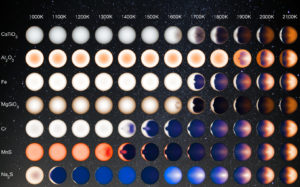
What hot Jupiters might look like for a range of atmospheric temperatures. From http://www.jpl.nasa.gov/spaceimages/details.php?id=PIA21074.
Second day of DPS, and I enjoyed several fascinating sessions on exoplanet atmospheres. One of the most visually appealing talks was given by Vivian Parmentier, a planetary scientist at the Lunar and Planetary Lab.
Parmentier talked about clouds in the atmospheres of hot Jupiters, gas giant planets similar in composition and structure to Jupiter but much closer to their host stars than Mercury is to our Sun. Because they’re so close to their stars, hot Jupiters are … well … very hot, with temperatures reaching thousands of degrees.
These very high temperatures probably mean that the atmospheres contain clouds made of some exotic condensables, such as iron, cromium, or even ruby.
In his talk, Parmentier explained that understanding what kinds of clouds might form in these atmospheres is important for interpreting the growing collection of spectra collected using the Hubble and Spitzer Space Telescopes. He also showed a beautiful photo album, realistically depicting the appearances of hot Jupiters for a range of atmospheric conditions.
A detailed, if nuanced, story is emerging from these data, suggesting hot Jupiters have highly dynamic meteorology with chemically complex clouds.
I attended the Women in Planetary Science Discussion Hour, at which we addressed several issues confronting the planetary science community when it comes to expanding diversity in the field. Several planetary scientists have conducted recent studies revealing the current state of the field (e.g., the fraction of women involved in space missions has not kept pace with the fraction of women in planetary science overall).
These studies have also pointed out ways to expand our pool of talented scientists, including ways to improve faculty searches to make sure the people standing at the front of the classroom resemble more closely the people sitting behind the desks. The Women in Planetary Science blog gives a lot of relevant resources.
